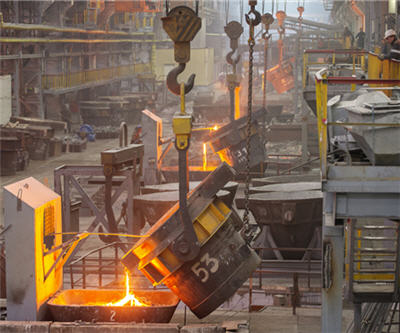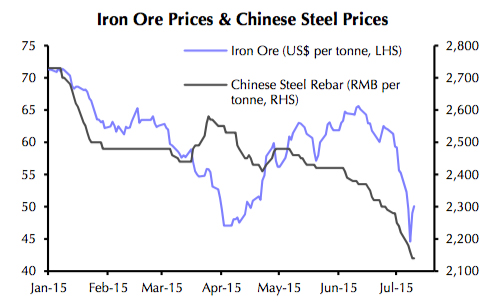
The price of iron ore regained the psychologically important $50 a tonne level on Wednesday as the market for the steelmaking raw material stabilized following last weeks wild swings up and down.
The benchmark 62% Fe import price including freight and insurance at the Chinese port of Tianjin added $0.70 or 1.4% to $50.10 a tonne according to data provided by The SteelIndex.
Last week the spot price reached an all-time low of $44.10 a tonne in a knee-jerk reaction to the chaos on Chinese equity markets which was only made worse by the Greece-related turmoil in Europe.
After almost halving in 2014, the price of iron ore is still down nearly 30% this year from opening levels above $70 a tonne.
China forges almost as much steel as the rest of the world combined and the country sucks in more than 70% of the world’s seaborne iron ore.
The disconnect between Chinese steel and iron ore prices points to underlying weakness in the market.
Unlike iron ore, Chinese steel prices has not really bounced back and on Wednesday the most-traded rebar contract on the Shanghai Futures Exchange closed nearly a 1% down at 2,057 yuan ($330) per tonne.
Last week January steel deliveries fell to a record low of $305.
A slowing economy and rapidly cooling property market has the country’s steel consumption contract by more than 5% in the first five months of 2015.
Chinese steelmakers have not shut capacity at nearly that rate and crude steel output is down only 1.3% compared to the first half of last year.
A crackdown by Beijing on the country’s most polluting industries and no prospect of a pick up in demand could see more shutdown the rest of the year however.
A new research note by Capital Economics says the adoption of protectionist policies towards the country’s exports is another factor putting pressure on steel prices:
The recent slide in iron ore prices may provide some relief to China’s struggling steelmakers, but is unlikely to prevent a contraction in steel output this year.
As such, iron ore producers will increasingly be in competition for market share, albeit in a shrinking market. Australia’s producers are low-cost but producers elsewhere, notably in Africa and Iran, will be loss-making at current (and higher) prices.
The independent research house would not rule out “deeper falls in the iron ore price over the next couple of months” but is sticking to an end-2015 forecast of $45 per tonne.
Capital Economics expects a modest recovery to around $55 by the end of next year as higher-cost output leaves the market and global economic growth starts to pick up moderately.

Source: Capital Economics
Comments
Leonel Lopez
In iron ore consumption China is at the level that have been planning for many years. First they purchase the raw materials needed for feeding their own smelters, at the prices that they want. Out of their consumption the rest is sold at prices that reflect their operating costs with cheap labor, cheap environmental compliance, etc. and invade the World with their cheap products at low prices to eliminate the local producers. The rest of the World producers, mainly the major producers play their game for trying to export as much iron as they can produce. What is happening meanwhile with Australia and Brazil?. Well they will exhaust their prime materials or high grade ores trying to make a profit, while they will be subjected in the future to purchase iron from other sources, or Chinese producers which are buying the ore deposits, again at the prices set by China. We must recognize that China has been controlling the metals prices for many years and the rest of the World should learn their game.